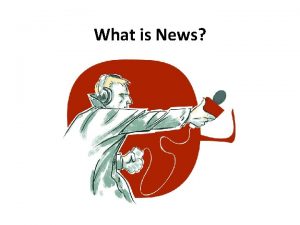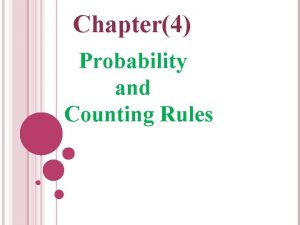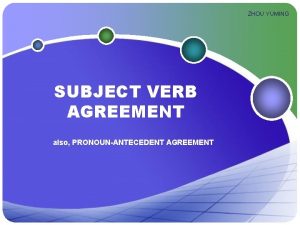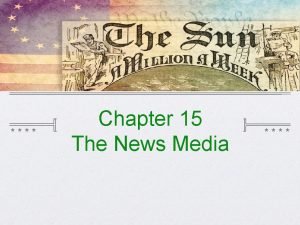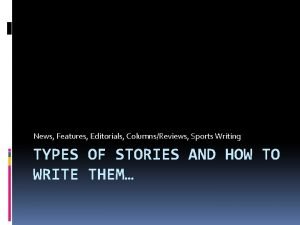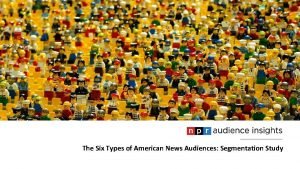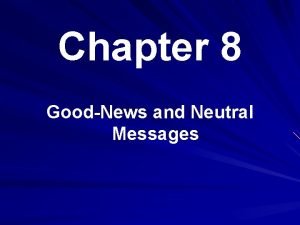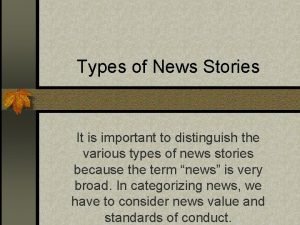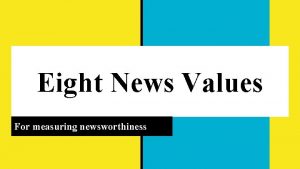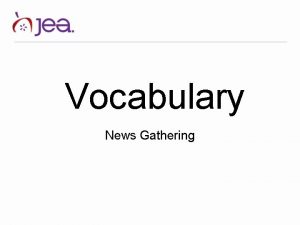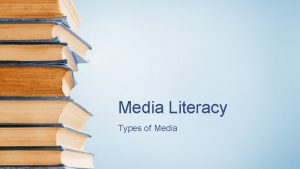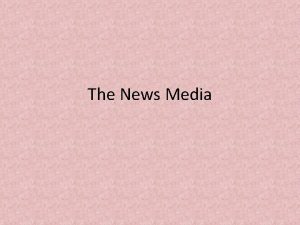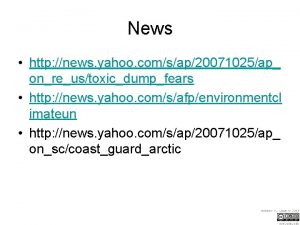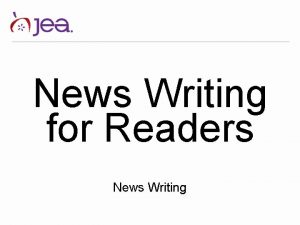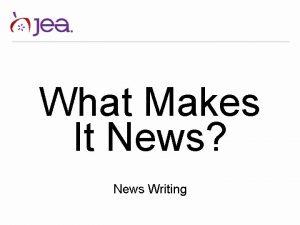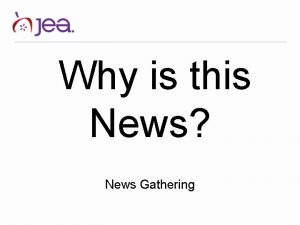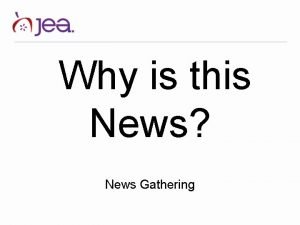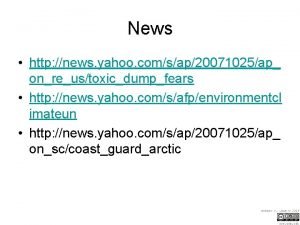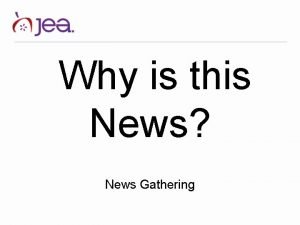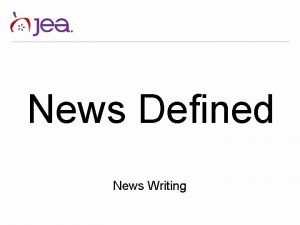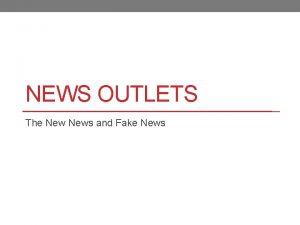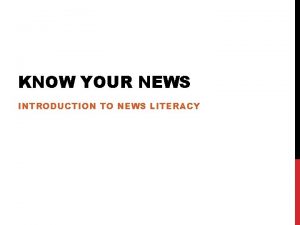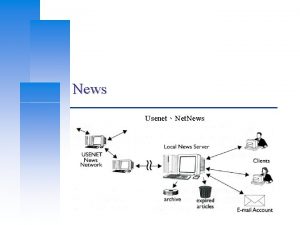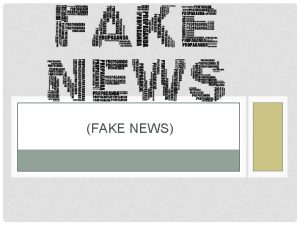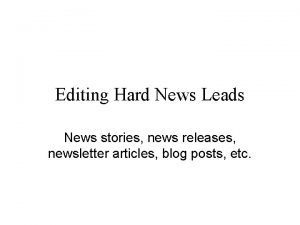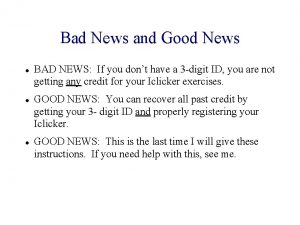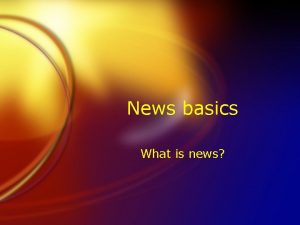Chapter 15 The News Media Types of Media





















































- Slides: 53

Chapter 15 The News Media

Types of Media Different media have distinct characteristics on the communication of political news Television News Reaches more individuals than any other news source Provides little depth of coverage Resembles newspaper headlines connected to pictures

Radio News Is largely a headline service (but without TV’s pictures) All-news stations provide some more coverage but are repetitious Talk-radio has become an important political force in recent years. Newspapers Have lost their place as the dominate news source Often set the agenda for broadcast news sources Continue to be the primary source of news for the educated and influential

Figure 15. 1: Where do Americans get their news?






Contemporary Media A number of newspapers have a national audience and are considered quite influential: The New York Times The Wall Street Journal USA Today The Christian Science Monitor The Washington Post The Los Angeles Times These newspapers have a huge effect on television

Broadcast Media Radio news evolved in early 1900 s Today, talk radio is a source of political commentary Television becomes major news source in 1960 s It remains a major news source today Movement away from network news to cable Growth of comedy news programs

Current Media Trends Influence of networks, affiliates, and wire services Increasing media consolidation Greater reliance on experts and pundits Use of cable channels for narrowcasting Development of technological innovations such as blogs Growth in number of citizen journalists

Radio News FDR’s Fireside Chats Today AM Talk - conservative dominance Liberals - National Public Radio

Media and the Public Knowledge is POWER Ninety-eight percent of all Americans have a least one TV There are over 1500 newspapers with daily circulations of 60 million There are three major weekly news magazines that claim nearly 10 million readers (Time, Newsweek, and US News and World Report)

Media’s Influence on Public Press has little effect on long term beliefs Media effects may lead to short term changes in opinion Media sways uncommitteds and raises new issues May also play agenda setting and framing roles

Sources of Media Power Agenda setting - The power of the media to bring public attention to particular issues and problems Framing - The power of the media to influence how events and issues are interpreted

The Media’s Role The mass media preform a mediating role - helping to shape political attitudes and choices but not determining them

Agenda Setting The mass media may not be successful in telling people what to think, but they are stunningly successful in telling their audience what to think about This power is greatest among those who are neither interested nor involved in politics and hence lack political sophistication

Politics & Popular Culture The Role of Blogs and Blogging Web logs, or blogs, are increasingly important sources of political information and commentary for many Americans, particularly young Americans

The Internet Has grown in importance in recent years Could provide the depth of print coverage with the timeliness of broadcast

Public’s Perception of the Media Public opinion of media is relatively critical Perceive media to be: Politically biased Roadblocks to solving problems Inaccurate in their reporting Unwilling to admit mistakes Most still view the national news media as credible Terrorist attacks shifted public opinion positively for a period Value the watchdog role of the news media

Confidence in the Media General confidence is on a downturn Republicans are more critical than Democrats and Republicans use different sources Ideological fragmentation may be cause for concern People tend to choose news that supports their opinion



Media Bias What is bias Reporters have liberal bias but editors/owners do to Does it come out in the news? Not really but incumbents/negative/President vs Congress/lack of substance Ways to deal with possible bias

1980 s and 1990 s argument that media was liberally biased because of sheer number of journalist who leaned to the left Another argument focuses on corporate interests and the influence on what is covered Media critics: focus on national media’s lack of skepticism regarding the invasion of Iraq Recent media bias is intentional and a response to increasing fragmentation and competition among media Mainstream media losing market share while online and alternative media are growing Market position CNN: 27% of Democrats, 20% of Republicans Fox News: 29% of Republicans, 14% of Democrats Ideological fragmentation is viewed as a negative trend by those who believe that the mass media are essential to providing the facts to educate the public about politics



Media Bias Question about effects of media bias Media bias unavoidable - journalists are human Media generally thought to be liberal Recent growth of conservative news sources Looking at good stories over issues Can be charmed by interesting personalities

Imperviousness of Beliefs Generally neither reading nor watching the news alters what people think Selective Perception is a pervasive human tendency People search for “comfortable” information that “fits” with preexisting beliefs People screen out or reject information with which they disagree In short, we see what we want to see and hear what we want to hear

Media bias is unavoidable - journalists are human media generally thought to be liberal prefer good stories over issue analysis can be charmed by interesting personalities Public Confidence accepted as an authoritative source but Pew Research Center Poll: 63% believed press was inaccurate

A Complex Relationship between the media and policymakers is both subtle and complex No easy conclusions about who influences whom in what circumstance can be drawn TV has quickened the pace of the news but it by no means determines American public policy However, it is also clear that the media is a powerful institution that affects multiple facets of American political life

A Reciprocal Relationship Politicians actively court the media’s favor and ascribe to the media the power to make or break government Research shows that the mass media has an effect both on public opinion and on the shape of policy choices decision makers face

The Media and Politicians Research indicates that roughly 2/3 of officials in policy decisions reported that the media was their most rapid source of information Over 4/5 indicated that the media was an important source of information

How Politicians Use the Media Politicians and government officials often stage media events in order to gain free media coverage Candidates and politicians try to control or “spin” media focus regarding campaign and policy issues Candidates and politicians may “leak” a story to the press in order to get their story out without being the focus of that story

Pace of News The increasingly rapid pace of electronic news and TV’s global coverage shortens the time frame for policy responses In 1961, when the Berlin Wall went up, President Kennedy had eight days to respond to the provocative action In 1989, when the wall came down, President Bush was forced to respond overnight

In recent years the media has become increasingly partisan As news sources expand to include not only broadcast networks and newspapers but also cable news channels, talk radio, and websites on the internet designed to appeal to specific groups, news is increasingly becoming politicized.

TV Network Programming A full transcript of the typical nightly network news broadcasts - foreign and domestic - would not fill half of the front page of an average daily newspaper Yet 3/4 of the American people routinely depend on this source for most of their foreign affairs information

Inadvertent Audience TV provides the mass of American people with an infusion of policy information that most neither want or like There are three consequences of this forced media: TV may explain the decline of confidence in the nation’s leadership Being uninterested, Americans are unlikely to ave strong convictions about issues as do those who regularly follow political affairs Policy ideas must fit into “one-liners” that will fit into 30, 60, or 90 second slots on the evening news

Covering Government President garners most attention through bully pulpit Speaks through press secretary or press conference Coverage of President is generally unfavorable Congress’ 535 members pose a challenge Coverage of Congress is also generally negative Supreme Court is more private, coverage limited

Covering the Presidency President is the focus of the most media coverage Can summon the press at will FDR was the first to use the press conference as a means to shape public opinion and explain actions Press Secretary - since Hover’s administration President’s main source of information to the press President gets the most coverage, but much of it is negative George W. Bush record low number of press conferences Strategy to control his image

Covering Congress Size of congress and its decentralized nature make it difficult for media to cover it Solve problem by: Giving leaders most attention Key committee chairs command center stage Local newspapers and broadcast stations devote some resources to covering their own representatives Coverage tends to be negative Focus on conflict Investigations may be covered, such as Enron

Covering Supreme Court remains a virtual media vacuum Broadcast media ban in court Use of audio recordings No cameras, but print and broadcast reporters have access to the Court

Government Regulation of Electronic Media Print media are exempt from most governmental regulation Electronic media are not Airwaves are considered public property and are leased to networks and private broadcasters by the government Government also allocates the use of frequencies and channels so that radio and TV do not overlap and jam each others’ signals

Limits on Media Freedom Equal Time Rule - Radio and TV must allow equal time to all candidates for office Fairness Doctrine - former policy that radio and TV had to provide time to all sides in programs of public interest Right of Rebuttal - The right to refute allegations presented on radio or TV station free of charge Prior Restraint - Government seeking to prevent publication before something is published

Interactions with the Media Officials may issue press releases May also hold briefings or conferences Speak to reporters on background or deep background May also get information off the record

Media and Democracy requires citizens to have access to information Citizens receive much of their information from the media Americans are skeptical of the information they receive from the media

Functions of the Media What functions do the media perform in a democracy? Means through which people learn about world events Interpret events by giving meaning and context Play important role in process of socialization cultivation of norms and values

Current News Media Trends Consolidation of privately-owned media Top 10 media chains account for more than 50% of daily circulation Concerns Market pressures Control of the flow of informaiton

Influence of networks, affiliates, and wire services Increasing media consolidation Greater reliance on experts and pundits Use of cable channels for narrowcasting Development of technological innovations such as blogs Growth in number of citizen journalists

Narrowcasting Fierce competition to attract viewers and the rise of cable and satellite television have led media outlets to move toward narrowcasting Fox News vs MSNBC Spanish-language news programs on stations such as Univision and Telemundo Black Entertainment Television Pat Robertson’s Christian Broadcasting Network

Citizen Journalists The rise of citizen journalists internet traditional media Pro: Democratization Con: Untrained in rules and standards of journalism

Rules Governing the Media Standards and norms of the journalistic profession 1996 Telecommunications Act Content regulation of the broadcast media Equal time rule Prior restraint permitted
 What are hard news
What are hard news Chapter 4 probability and counting rules answers
Chapter 4 probability and counting rules answers No news _____ good news.
No news _____ good news. News media types
News media types Hát kết hợp bộ gõ cơ thể
Hát kết hợp bộ gõ cơ thể Lp html
Lp html Bổ thể
Bổ thể Tỉ lệ cơ thể trẻ em
Tỉ lệ cơ thể trẻ em Voi kéo gỗ như thế nào
Voi kéo gỗ như thế nào Tư thế worm breton là gì
Tư thế worm breton là gì Bài hát chúa yêu trần thế alleluia
Bài hát chúa yêu trần thế alleluia Các môn thể thao bắt đầu bằng tiếng nhảy
Các môn thể thao bắt đầu bằng tiếng nhảy Thế nào là hệ số cao nhất
Thế nào là hệ số cao nhất Các châu lục và đại dương trên thế giới
Các châu lục và đại dương trên thế giới Công thức tính thế năng
Công thức tính thế năng Trời xanh đây là của chúng ta thể thơ
Trời xanh đây là của chúng ta thể thơ Mật thư tọa độ 5x5
Mật thư tọa độ 5x5 101012 bằng
101012 bằng độ dài liên kết
độ dài liên kết Các châu lục và đại dương trên thế giới
Các châu lục và đại dương trên thế giới Thơ thất ngôn tứ tuyệt đường luật
Thơ thất ngôn tứ tuyệt đường luật Quá trình desamine hóa có thể tạo ra
Quá trình desamine hóa có thể tạo ra Một số thể thơ truyền thống
Một số thể thơ truyền thống Cái miệng nó xinh thế chỉ nói điều hay thôi
Cái miệng nó xinh thế chỉ nói điều hay thôi Vẽ hình chiếu vuông góc của vật thể sau
Vẽ hình chiếu vuông góc của vật thể sau Nguyên nhân của sự mỏi cơ sinh 8
Nguyên nhân của sự mỏi cơ sinh 8 đặc điểm cơ thể của người tối cổ
đặc điểm cơ thể của người tối cổ V cc
V cc Vẽ hình chiếu đứng bằng cạnh của vật thể
Vẽ hình chiếu đứng bằng cạnh của vật thể Tia chieu sa te
Tia chieu sa te Thẻ vin
Thẻ vin đại từ thay thế
đại từ thay thế điện thế nghỉ
điện thế nghỉ Tư thế ngồi viết
Tư thế ngồi viết Diễn thế sinh thái là
Diễn thế sinh thái là Dot
Dot Số nguyên là gì
Số nguyên là gì Tư thế ngồi viết
Tư thế ngồi viết Lời thề hippocrates
Lời thề hippocrates Thiếu nhi thế giới liên hoan
Thiếu nhi thế giới liên hoan ưu thế lai là gì
ưu thế lai là gì Sự nuôi và dạy con của hươu
Sự nuôi và dạy con của hươu Sự nuôi và dạy con của hổ
Sự nuôi và dạy con của hổ Hệ hô hấp
Hệ hô hấp Từ ngữ thể hiện lòng nhân hậu
Từ ngữ thể hiện lòng nhân hậu Thế nào là mạng điện lắp đặt kiểu nổi
Thế nào là mạng điện lắp đặt kiểu nổi Flushleft
Flushleft News gathering
News gathering Types of news writing
Types of news writing Types of news segments
Types of news segments Types of good news messages
Types of good news messages Types of news stories
Types of news stories Types of news stories
Types of news stories Timeliness news stories
Timeliness news stories
